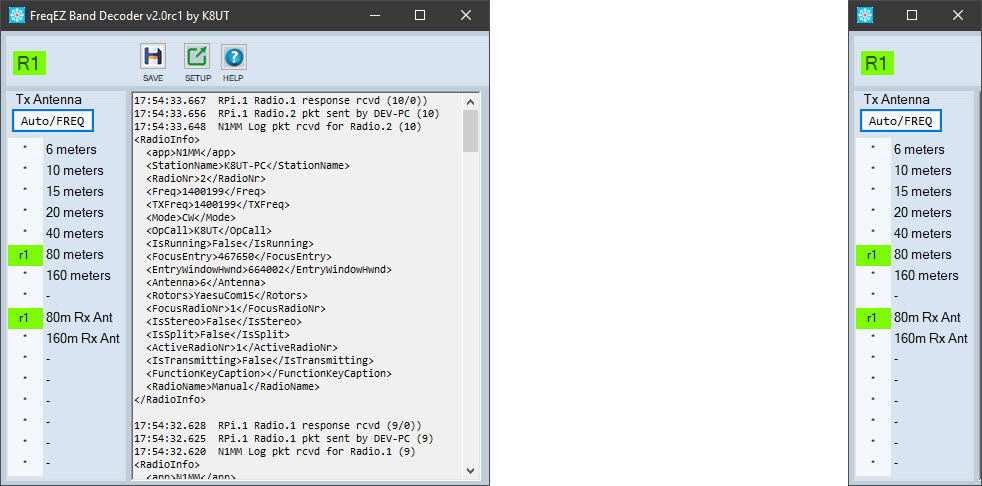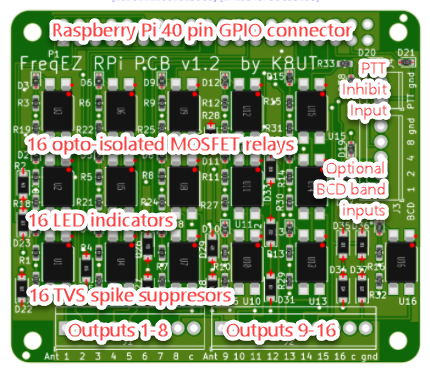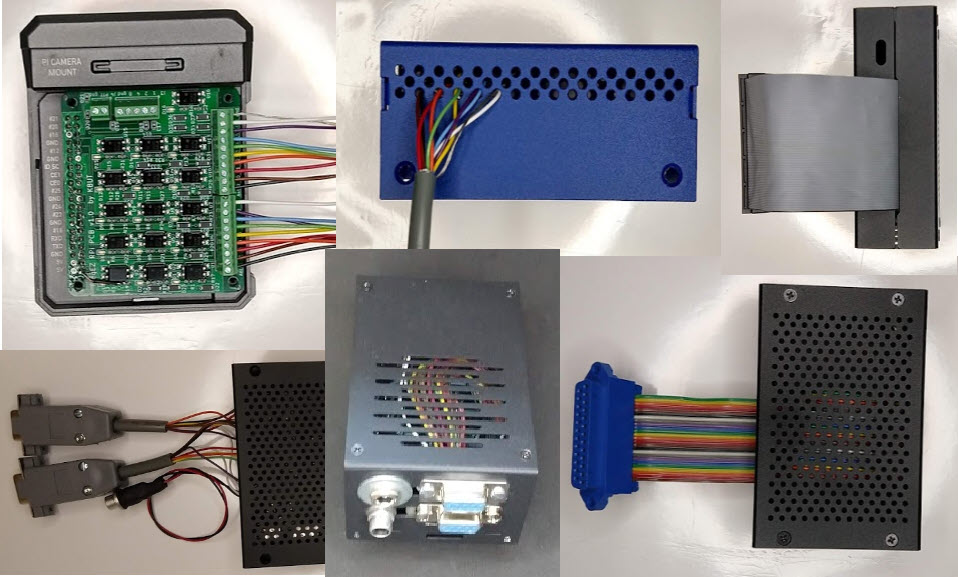FreqEZ HAS MOVED to www.freqez.com!
Click here www.freqez.com for the new website with latest software downloads, hardware, and documentation
The following material refers to the previous version, v2.0.4, of the FreqEZ Console and Controller


FreqEZ2 – v2.0.4a update released on August 11, 2022
Changes:
- Support for UcxLog and its dual radio operation (Radio 1 and Radio 2)
- Fix for packet display window incorrectly listing the RPi Controller port as the Console port number
- Improvements in handling XML errors in FreqEZConfig.xml or FreqEZSettings.xml files. Error dialog window will identify type and location of SXL error
- Fix for mis-formatted XML in UDP packet from logging program. FreqEZ will ignore the bad packet, display the packet contents in FreqEZ’s packet window, and continue operating
Overview
FreqEZ2 – A Versatile Band Decoder
FreqEZ is a combination hardware/software project that provides highly configurable Band Decoding and Remote Antenna selection. For amateurs who use N1MM+, Logger32, UcxLog, Log4OM, or DXLab logging software, FreqEZ will leverage those programs’ UDP packets for antenna switching. For other amateurs, FreqEZ can connect to the BCD band outputs available from most transceivers. Without available UDP packet or BCD band information, FreqEZ can also be used as a sophisticated manual antenna switch.
- FreqEZ software is a pair of programs running a Windows FreqEZ Console (freqezwin) and a Raspberry Pi FreqEZ Controller (freqezrpi). Both programs are free to all hams.
- FreqEZ hardware uses a Raspberry Pi platform with a controller board to enable remote antenna switches. The Controller hardware can be a pre-assembled and tested Raspberry Pi HAT (Hardware Attached on Top) circuit board purchased from K8UT or a Do-It-Yourself construction project from the provided parts list and documentation.
Copyright
This software is copyrighted freeware. You can use, modify, and distribute the software provided that you offer it and any derivative works as freeware. Any commercial use must be approved in writing by the author.
Disclaimer
This software controls equipment that could be damaged by said software. You are responsible for installing, configuring, testing and ensuring that the software performs properly in your environment. The author cannot be held liable for any direct, indirect, consequential or incidental damages to other pieces of software, equipment, goods or persons arising from the use of this software.
By downloading this software you accept the above terms of copyright and disclaimer.
Key Features
- The FreqEZ2 software is free
- Inexpensive, off-the-shelf, readily available hardware
- No DIP switches, diodes, solder-bridges. All configuration is via software settings
- Manual antenna selection with simple mouse clicks in the Windows FreqEZ2 Console
- Automatic antenna selection from network-based UDP packets or hard-wired BCD inputs
- In N1MM+ – use the antenna numbers from the Configurer >Antenna table
- Supports the N1MM+ Keyboard Shortcut for multiple antennas per band by toggling <alt>+F9
- In Logger 32, DXLab, Log4OM, UcxLog, TR4Win or N1MM+ – use the Tx radio frequency from the UDP RadioInfo packet
- Auto-magic switching (no re-configuration) from N1MM’s antenna numbers to Logger32 (v4.0 or lter), TR4W (v4.100.10 or later), or DXLab Commander’s Frequencies
- Hard-wired method, for logging programs that do not support UDP broadcasts
- Connect to a transceiver’s BCD output jack
- OR… use BCD signals from a PC LPT parallel port (supported by some logging programs) {ugh!}
- In N1MM+ – use the antenna numbers from the Configurer >Antenna table
- Single Op Profiles in the Setup window for SO1V, SO2V or SO2R configurations
- Optional different antenna selection for Radio1 versus Radio2 with N1MM+
- The FreqEZ2 Console and the FreqEZ2 Controller communicate via WiFi or wired Ethernet connections
- The Raspberry Pi FreqEZ2 Controller operates “headless” – can be located anywhere
- Each FreqEZ2 Raspberry Pi Controller contains 16 outputs
- The FreqEZ2 HAT Controller provides 16 bi-directional opto-MOSFET solid-state devices that can each handle 20 volts AC/DC at up to 500 milliamperes
- The FreqEZ2 DIY Controller provides 16 “dry contacts” that sink (ground) or source (+12 vdc) in any combination from two SainSmart relay boards
FreqEZ2 Band Decoder Frequently Asked Questions (FAQ)
Read the FreqEZ FAQ HERE
Watch a FreqEZ2 Overview video HERE
FreqEZ RPi HAT Board – Assembled and Tested
Pricing and Order information HERE
The miniature Raspberry Pi HAT board that provides all of the features of the original DIY hardware but fits in a standard RPi Case. The printed circuit board is fully populated with all components, assembled and tested. See case and wiring photos in the FreqEZ2help.pdf documentation.

Do It Yourself (DIY) Alternative
A FreqEZ DIY Parts List contains components that were intentionally selected as being inexpensive and globally available. Using popular sources like Amazon, eBay, Mouser and DigiKey, hams should be able to purchase all of the FreqEZ components for less than $100 (US).


Software
FreqEZ2 is a pair of companion software applications that run on a Windows PC and a Raspberry Pi (RPi) single-board computer. The user interface and software configuration run on Windows; the remote antenna switching runs on a Raspberry Pi. These two companion programs communicate via Ethernet or WiFi using an async UDP packet protocol.
The N1MM+, Logger32, and DXLab Commander logging programs send UDP packets containing radio information that the FreqEZ2 Console receives and interprets according to the FreqEZ2 configuration settings. The Console creates command strings that are sent to the Raspberry Pi Controller, enabling any combination of up to 16 devices (i.e. antenna switches, band filters, receive antennas, transverters…) per Raspberry Pi Controller. From DXLab Commander, that radio information is the transceiver frequency in the <TXFreq> field. From N1MM+, that radio information could be the transceiver TX frequency, or it could be the packet’s <Antenna> number field entered derived from the N1MM+ Antenna configuration table.
NOTE: The Raspberry Pi Controller program, freqezrpi, is a 32 bit application and is not compatible with the new 64 bit Raspi O/S. When burning an image on your microSD card be sure to select a 32 bit version of the Raspbian operating system.
Required Materials
- Raspberry Pi 4 2gb recommended, but runs on any Raspberry Pi model 3 or 4
- MicroSD card Class 10, at least 8 gb
- Case for the Raspberry Pi (see examples in Help file)
- Power Supply or USB cable with connector that matches your Raspberry Pi
- The Raspberry Pi 4 uses a different power connector (USB-C?) and draws more current than previous Raspberry Pi models. You may need a new USB cable or a new power supply intended for the Raspberry Pi 4
- Mouse, Keyboard and Monitor to use temporarily while configuring the Raspberry Pi
- The Raspberry Pi 4 uses a micro HDMI connector. You may need a new cable or an adapter to connect your monitor to the RPi
- FreqEZ2 RPi HAT Controller Board or DIY Controller Assembly (see old-assembly instructions)
Purchase
- The FreqEZ2 Software is free. See Download/FreqEZ2
- FreqEZ Rpi HAT Circuit Board – Click HERE
- Optional for the Do-It-Yourselfer
- See parts list in the >Downloads /FreqEZ2 folder
Download
The FreqEZwin and FreqEZrpi software is free. Latest versions are on the Downloads page HERE

Notes for Logging Program Developers
The UDP <RadioInfo> packet and its behavior is based upon the popular N1MM+ definitions. You can read more about this topic in the N1MM documentation.
These are the required fields in the UDP packet. There are other fields in the UDP packets from various loggers, but at least these must be included.
<?xml version="1.0" encoding="utf-8"?>
<RadioInfo>
<app>N1MM</app>
<RadioNr>1</RadioNr>
<Freq>352211</Freq>
<TXFreq>352211</TXFreq>
<Mode>CW</Mode>
<Antenna>8</Antenna> * required only for N1MM antenna number support
<IsSplit>False</IsSplit>
<ActiveRadioNr>1</ActiveRadioNr> *required only for SO2R support
</RadioInfo>
- XML tags are case sensitive. FreqEZ will not recognize <freq> and <txfreq> frequency. Must be <Freq> and <TXFreq>.
- <app> is a short name of the logger sending the packet. Examples: “N1MM”, “DXLab”, “Logger32”, “UcxLog”, “Log4OM”
- In Logger32, N1MM or DXLab Commander, if the radio is NOT in split mode, the logging program sends identical Freq and TXFreq values in the UDP packet. When the radio is in split mode (SO2V) the logging program sends the Rx VFO as Freq and the Tx VFO as TXFreq. (FreqEZ tracks the TXFreq)
- If the logging program is capable of operating SO2R (for example, N1MM) the logger sends two UDP packets – one for each radio. An additional <ActiveRadioNr> tag is added to both UDP packets. The ActiveRadioNr tag identifies which radio will be used for the next transmission. FreqEZ adjusts the antenna selection based on the <TXFreq> of the <ActiveRadioNr>
- FreqEZ ignores the <Mode> XML tag. This is not an issue for FreqEZ but might be for other applications.
- If the logging program does not know the radio frequency upon launch (there is no initial connection to the radio from the logger), do not initiate sending any RadioInfo UDP packets at all (better to send nothing than to send something that is wrong)
- When the logging program knows the radio frequency (if/when the logger establishes a radio connection) send RadioInfo UDP packets with TXFreq and Freq values
- If the logging program subsequently loses the radio connection, continue sending RadioInfo UDP packets with the last known values as TXFreq and Freq until the connection is re-established
-larry (K8UT) 2022-01-01
Support
If you have problems building or operating FreqEZ2, look for answers on the FreqEZ groups.io reflector. You do not need to register, or login, or even have an account to search for a solution to your problem. (Although you will need to register if you want to post a new question)
FreqEZ @ groups.io can be found HERE.
-Larry K8UT, FreqEZ developer